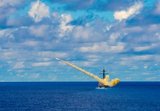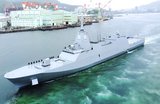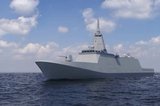Dstl tests autonomous launch and recovery system
The X-LARS trial USV in the autonomous Launch and Recovery System (LARS) cradle. (Photo: Dstl/ Crown Copyright)
The UK Defence Science and Technology Laboratory (Dstl) has developed and tested a concept for an autonomous launch and recovery system (LARS) that can receive USVs in a cradle.
The autonomous LARS is designed to negate the need to put human operators onto USVs to enable their launch and recovery.
Shephard understands that the goal of the development is to allow the RN to deploy and recover boats, such as USVs, with as minimal human input as possible.
Launching and recovering boats traditionally requires multiple crew members and a person onboard a vessel.
For USVs, this means sometimes launching another boat,
Already have an account? Log in
Want to keep reading this article?
More from Naval Warfare
-
![NATO tests use of “undetectable, jam-proof” laser communication in maritime scenarios]()
NATO tests use of “undetectable, jam-proof” laser communication in maritime scenarios
As part of its effort to better prepare its capabilities for operations in contested and congested scenarios, NATO evaluated a Lithuanian ship-to-ship terminal designed to not be susceptible to enemy interference.
-
![Future of the Canadian Patrol Submarine Project is still unclear]()
Future of the Canadian Patrol Submarine Project is still unclear
The Canadian government remains tight-lipped on the timeline and funding required for the next steps of its Canadian Submarine Patrol Project, which should offer improved capabilities for the country’s navy.
-
![Mitsubishi eyes future with Australia’s Mogami selection]()
Mitsubishi eyes future with Australia’s Mogami selection
With Australia’s selection of the Mogami-class for Project Sea 3000, Mitsubishi is investigating local production in the next decade as potential export opportunities emerge.
-
![Thales’ new Sonar 76Nano could equip UK Royal Navy on anti-submarine warfare missions]()
Thales’ new Sonar 76Nano could equip UK Royal Navy on anti-submarine warfare missions
The new sonar is designed to equip uncrewed underwater vessels, with the potential to be used by the Royal Navy for its Atlantic Bastion and Atlantic Net missions.























